Chief Minister A Revanth Reddy, accompanied by Ministers Uttam Kumar Reddy and Komatireddy Venkat Reddy, inspected the crucial aerial electromagnetic survey launched for the Srisailam Left Bank Canal (SLBC) tunnel works.
The heli-borne magnetic survey, conducted using a special transmitter fitted to the helicopter, will collect geological data up to a depth of 1,000 metres. It aims to identify underground shear zones and water flow patterns, which are critical for planning and executing the SLBC tunnel works.
The helicopter carrying the Chief Minister and Ministers also took off alongside the survey helicopter and travelled parallel for a few kilometres to observe the process from the air.
Mr. Uttam Reddy said Telangana has entered a new phase of science-led irrigation management with the launch of the helicopter-borne VTEM Plus electromagnetic survey, and it would provide precise underground data to safely complete the remaining works within two years and deliver water to millions of people across Nalgonda and Mahabubnagar districts.
Mr. Reddy detailed how the survey, being executed by the National Geophysical Research Institute (NGRI), employs the Canadian-made VTEM Plus system capable of detecting geological conditions up to 1,000 metres deep. A large transmitter loop suspended 100–150 feet beneath the helicopter emits electromagnetic pulses into the ground, while sensors record reflections that reveal variations in rock structure, water flow and mineral composition.
“The data will allow us to pinpoint fault zones, shear planes and underground water pockets with high accuracy,” the Minister said. Flights are being carried out along straight, parallel paths across the entire 44-kilometre alignment, and each run will be repeated if verification is required. The three-day survey will generate detailed 3D resistivity and conductivity maps, which will guide engineers in tunnel alignment, reinforcement and drainage planning.
The NGRI scientists would process the field data in Hyderabad using specialised software to develop a three-dimensional geological model of the SLBC corridor. “The combination of aerial precision and scientific analysis will give a complete picture of subsurface conditions and guarantee the safety of future tunnelling,” he explained.
To enhance technical supervision, the government has roped in senior engineers from the Indian Army’s Corps of Engineers. Former Engineer-in-Chief of the Indian Army Lt. Gen. Harpal Singh (retired) has been appointed advisor, and Col. Parikshit Mehra, who oversaw major tunnelling projects under the Brahmaputra River and at Rohtang Pass, has been deputed to supervise execution.

 1 day ago
4
1 day ago
4










 English (US) ·
English (US) ·